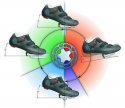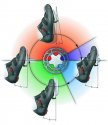imvho the boom looks to be too far out, at the point on the chainset between where the hour hand is 2-4 o'clock your toes are more forward than your heel, I'd expect this to be the opposite way around with your heel being more forward than your toes, I believe the term is ''ankling''.
Ok this could get complicated, you have been warned, there be angles a foot

Jason ankling is pretty solid and close to textbook to my eye, this was a topic I've been studying because of the way Larry and Eric Winn pedal compare to the way I do, trying to figure out why we do it differently and why I can't match what they are doing positionally; and lastly whether it mattered. I believe I have it figured out but had not had time to post about it.
According to current best practices that I have read about at, In the two non power phases of the stroke you heel should be a 20 degree up from being perpendicular to your body's vertical line. During the power stroke that should reduce to the range of 0 to -10 degrees How far towards -10 you get depends on your knees, leg length, and the strength of your calves. Good so far and matches
@leetaylor55 assertion; standard text book and what one would expect on a Wattbike.
Drawing #1 is the Stand DF diagram for proper ankling, (borrowed from bicycling.com)

Drawing #2, below, is this same idea rotate 90 degrees if the athlete where laying on his back, but maintaining the same pedaling geometry. This would seem to imply leading with the heel. But.... this is really more the realm of the Stick bike, or a NoCom lowracer with the rider's feet way up in the air. DF riders sit butt behind the pedals and stick riders are feet above butt (sometimes way more than this 90 rotation); this is where the -10 comes from in ankling, the feet are forward slightly of the body so there is a backwards lean; just a little but enough that 0 to -10 degrees is implied. If we laid prone and road our bikes this would be pretty valid; as the feet go up this has to rotate more counter clockwise (there is a limiter on how far back is efficient, but that's another topic)

Next Drawing #3, below, is rotated 20 degrees forward for the V20 position (generalized). This rotation places the center of the power stroke right where John Tolhurst reported it should be, 65 degrees back from the 3 o'clock position, for a typical riders sized on at Cruzbike V20. This was discussed, a long time again and referenced more recently when we were first discussing Qrings about 2 years ago. John had blog post about it and a bunch of tech stuff published with drawings, but that info didn't make the transition from the old website to the new one.
Drawing #3 is about how mine looks with the stock seat and the medium chain stay; it's also how most of the Q-Ring photos appear in that thread and why most of us can use the same OCP setting. Under this assumption the heel should remain back 20 to 10 degrees from vertical during the power stroke. (this is the 0 to -10 degrees from drawing #2 rotated forward 20 degree)

So here are the observations:
(1)
@LarryOz and
@Eric Winn have stated they are pretty well pedaling with a vertical foot in the power stroke; they are also two of the tribe's (self acknowledged) short riders. On the medium chain stays configurations, which they ride; they will have higher feet than most people because they have to really shorten the boom to match their x-seams, they will be rotated to prefer a a vertical foot and it will be correct. Their rotation is closer to drawing #2 than drawing #3. This is also likely why Larry prefers a different OCP to most of us on his Q-rings. Different angles of attack and different rotations.
Lee what length chainstay to you have and what's your x-seam?
(2) Jason's longer legged, and has the thor seat. His position is somewhere between drawing 2 and 3 but I think a lot closer to #3 in most of the photos I've seen; (we don't have a definitive 90degree shot) Now go back and watch Jason's video. The angles are a little desceptive as they are shot behind the centerline. Notice how incredibly consistent his 20 degree angles are in the back-stroke relative to this rotation and you can see him ankling down about 10-15 degrees
into the sweet spot, it is not vertical due to his fit on the bike. This is what I would expect given the record setting performances he has generated. If (a) Jason goes to a shorter crank arm and does not change his boom length, this will help his knees somewhat, and his foot angle will approach The 5-10 degrees range . I do not think he will be vertical, but it will head in that direction. If (b) he shortens his cranks and lengthens his boom his angle will stay about as it is and it will help open his knees even more. "B" is probably preferable to "A" but that my opinion that favors knee health over bringing more power from the hamstrings into the power game.
(3) Mine is almost exactly drawing number three with the stock seat and a medium chain-stay, and short cranks. I am not going to get a vertical push to match Larry and I should not try on my current setup as I would have to induce a lot of knee bend to get my boom that short. I have been contemplating going to a longer chain-stay to shift my rotation towards drawing #2 and a more straight on leg press push foot angle. Lengthening or Shortening the chain-stay is the only real way you can alter these angles by a large margin.
Ok so the take home points are: ?
- Boom angle / BB height relative to the 20 degree plan of the seat; will dictate how vertical the position of your foot should be for maximum efficiency.
- The higher the BB the more vertical your foot will point and how much you approached negative 10 degree in most cases.
- The lower the BB the more your toes are going to point.
- Just shortening the boom to get the foot vertical will not always work if it means you will drive your knee bending back to a point of greater than 90 degrees.
- Crank length has a minor effect on ankling depending on how you adjust for it, and is most useful to fix knee bend that is introduced trying to get the feet higher with a shorter boom.
- Chain-stay lengthen vs rider height is the number one limiter / lever for change.
- Unfortunately it is all connect and there is no 1 adjustment.
Lee I think you are correct about the angle of the foot relative to the centerline rotation; it matches the experts. But I think we have to consider centerline changing as the bike is adjusted to compensate for the limitation of the knee angles. Or in short I do not think vertical is a fixed reference point for us. Instead it is off set by the positioning of the butt relative to the BB height; and can sort of be generalized by referencing the seat angle for the sake of rough discussions, and find people a baseline for themselves.






